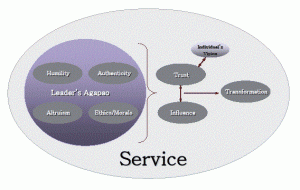Authentic Transformational Servant Leadership
You may be asking yourself . . . “What is this? I’ve heard of transformational leadership and I’ve heard of servant leadership; but what is this, a combination of both? And, why?”
Let’s start from the beginning and try to make sense of this . . .
As you have been navigating through the theories and styles of leadership, you have learned that the Servant Leadership style was re-introduced by Robert Greenleaf in the mid-1970s and the Transformational Leadership style introduced in the mid-1980s. Both have similar attributes but there are some emphases that require closer attention and review.
Greenleaf’s re-introduction began a resurgence of interest and debate of the applicability of the notion that the leader also serves from a servant perspective. Furthermore, the attributes of the servant leader are specific, not-negotiable, and integral to this model, subsequently enabling the leader to empower followers through the leader’s service to them. Again, this service to followers is not out of a sense of obligation, but out of a sense of leadership.
The leadership model I developed and introduced, takes the attributes of a servant leader and combines them with those of a transformational leader. There are some critical differences, however, that are necessary for this century’s faced-paced, ever-changing environment which dramatically affect organizational dynamics.
Below is the model of authentic transformational servant leadership. In addition to the pillars necessary for servant leadership (leader’s agapao, humility, altruism, vision, and trust), inherent in this model is the necessity of authenticity (as opposed to being pseudo-transformational – change for self-aggrandizement or to serve self), a strong foundation of ethics/morals (implied in the servant leadership model), and a shift in the emphasis on vision. Furthermore, since a transformational leader is, by definition, an agent of change, this component is incorporated as an outflow – along with service.
Let me explain this further . . .
In the servant leadership model, vision relates to the vision of the followers; the servant leader is more concerned with enabling the follower to achieve his or her personal vision than for the organization to achieve its vision/goal. In the authentic transformational servant leadership model, although the attributes of the servant leader are readily apparent (and critical), the leader – through a foundation of humility, authenticity, altruism, and ethics/morals – engenders trust with positive influence. He or she then helps followers achieve personal vision as they embrace the organization’s vision, thus adopting it as part of their own personal goal. Through empowerment, followers are compelled to be transformed in their hearts and minds and thus serve in a manner that enables them to accomplish more than they believed they could previously. Service refers not only to the leader’s position in relationship to the followers but the posture followers take within the organization in response to the leader’s example.
It is essential to reiterate that, by definition, a transformational leader is an agent of change. Inherent in this model is the necessity to proactively anticipate uncertainty and prepare the organization for change. Because of the volatility of change being experienced in today’s world and the anticipation it will only escalate in the future, leaders must constantly gather feedback and other internal and external information, re-evaluate current and future positioning, adjust the organization’s vision and goals, and ensure their authentic transformational servant leadership behavior is consistent.

